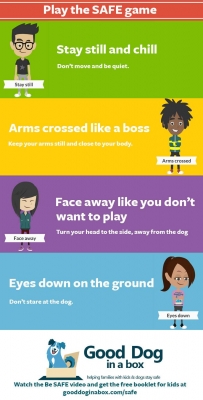The SAFE Program Promotes Practical Dog Bite Prevention

One of the most frustrating aspects of being a dog trainer is not being able to get information across to the people that really need it the most, especially when it comes to dog bite prevention. Or, seeing solid information about dog emotion,stress signals, and body language go in one ear and out the other of the general public. Just five minutes on Facebook speaks volumes. The range of inappropriate and sometimes dangerous videos and pictures of children interacting with dogs being shared by our own friends and relatives tells us that our messages about bite prevention are not reaching the masses.
It’s quite easy to point out all the things that people are doing wrong with their dogs. How do we, as experts in canine training and behavior, get people to listen especially about their children’s safety, without talking down or alienating them? My friend and founder of Family Paws Parent Education Jen Shryock often says that these people are just like us, but with less information. We have to find new ways to reach them.
Let's start by making dog bite prevention fun. By presenting simple tips on how to keep children safe around dogs in a clever, engaging way. And we have to make it free with downloadable resources for parents and kids to share.
Those are all the ideas behind the SAFE Dog Bite Prevention Program. SAFE stands for the four body language cues that a child can do to diffuse an encounter with a dog that approaches them. The four cues are set to four rhyming phrases:
1. Stay still and chill-don’t move and be quiet. This is perhaps the most important in that, we want the child to remain calm and not run away.
2. Arms crossed like a boss-keep your arms still and close to your body. Again, we want to encourage staying calm and not raising arms or waving them around.
3. Face away like you don’t want to play-turn your head to the side, away from the dog. Much like a look away calming signal, just a turn of the head to keep the peace.
4. Eyes down on the ground, don’t stare at the dog. Encountering a strange dog is definitely the one time we don’t want a child to be staring or making direct eye contact.
The four steps of SAFE are presented as a game, all about making the situation as calm for the child as possible and as boring for the dog. SAFE can be taught to children to use if they encounter a dog they don’t know without an adult around or in the presence of a dog they do know since most dog bites occur between dogs and children that have some familiarity.
And what better way to present SAFE than with a short animated video that shows children how the game works. We include a colorful infographic, coloring pages, and a wall chart that parents can download. All available for free at http://www.gooddoginabox.com/safe-dog-bite-prevention-program/
Help us spread the word about the SAFE game during National Dog Bite Prevention week!!




